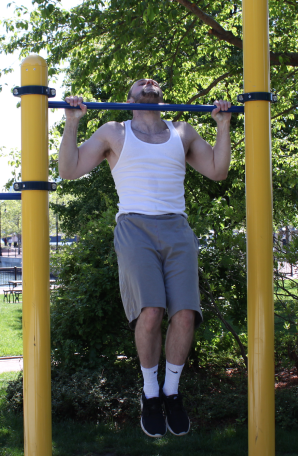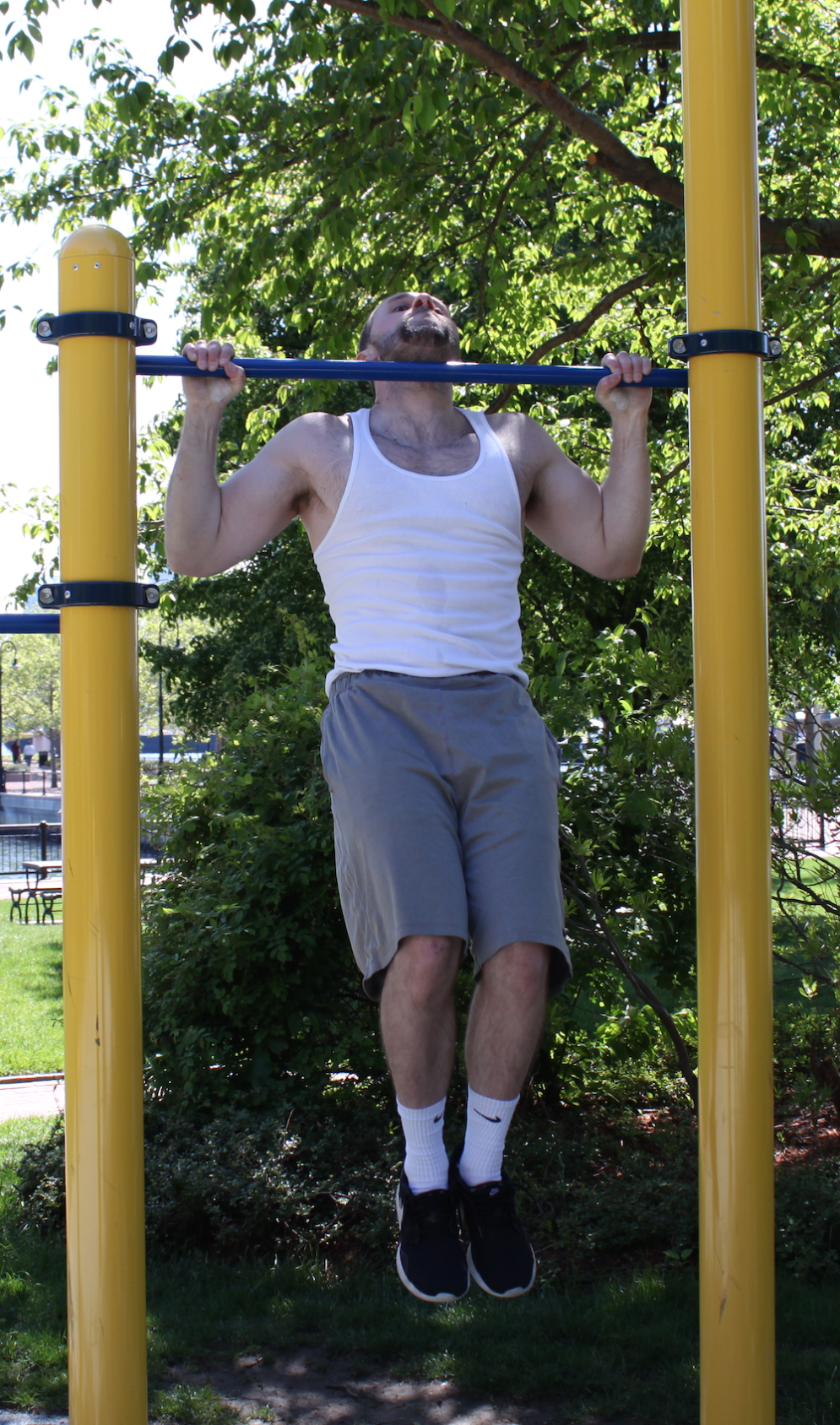Pullups
In
Coast Guard Boot Camp
Pullups
In
Coast Guard Boot Camp
Pullups
In
Coast Guard
Boot Camp
NOTE: All references to pullups and chinups in this article refer to deadhang pullups, where you go all the way down until your elbows lock out and all the way up until your chin clears the bar. No kipping.
Pullups In Coast Guard Basic Training?
Why am I writing a lesson on pullups in Coast Guard Boot Camp when they aren’t required for the physical fitness test?
Well I know that the Coast Guard is not the Marine Corps, but you should follow your brothers and sisters in arms and include pullups in your training regimen. By the way, if you ended up on this page and you ARE training for the Marine Corps PFT, this will help you too.
If you don’t have the strength to do even one pullup right now, don’t worry! I’ve created four routines for you and each one is geared toward a different starting strength level.
Before we get to those though, I want you to understand why you should be doing pullups in the first place.
Pullups In Coast Guard Basic Training?
Pullups In
Coast Guard
Basic Training?
Why am I writing a lesson on pullups in Coast Guard Boot Camp when they aren’t required for the physical fitness test?
Well I know that the Coast Guard is not the Marine Corps, but you should follow your brothers and sisters in arms and include pullups in your training regimen. By the way, if you ended up on this page and you ARE training for the Marine Corps PFT, this will help you too.
If you don’t have the strength to do even one pullup right now, don’t worry! I’ve created four routines for you and each one is geared toward a different starting strength level.
Before we get to those though, I want you to understand why you should be doing pullups in the first place.
The Benefits Of Pullups
1. Pullups develop overall upper body strength which will assist you with your performance on other exercises that the Coast Guard does require – including pushups. If you work on your pullups at the same time as you work on your pushups, your performance on pushups will improve much faster than if you only practice pushups.
2. Pullups work more muscles in your body than almost any other upper body exercise. They work various parts of your back, your shoulders, your biceps and forearms, and they even engage your core muscles.
3. The muscular endurance required for performing increasingly higher numbers of pullups will help you with swimming. While swimming is very unique and largely relies on technique, to some extent – especially for shorter distances like the Coast Guard’s swim test – you can slightly make up for sloppy form with solid muscle endurance.
I don’t want you to confuse the above statement with me telling you that you can somehow muscle your way through the swim test because that’s not what I’m saying. If you don’t know how to swim, you will have to learn. Pullups won’t do anything for your swimming technique, they’ll just help you with the muscle endurance required to complete the swim test. For more on that topic, please read swimming in Coast Guard Boot Camp.
4. You’ll be surprised but many of the Company Commanders at Cape May are former Marines turned Coasties. My Lead Company Commander was a Jarhead and before I even found out, I could kind of tell. Marines just have a presence to them that says “I kick serious @$$”. When my Lead Company Commander yelled at me I literally felt my soul shaking. With that said, Marines LOVE pullups. If one of your Company Commanders turns out to be a former Marine, he will probably make you do pullups at some point during PT – mine did. This is where you can earn bonus respect points. If you can bang out more pullups than the rest of your company or even just put up some good numbers, it’ll help you.
I could keep going on and on about the benefits, but I want to get to the actual routines. The bottom line is that they are extremely good for you and should be included in any workout regimen. Again, it doesn’t matter if you can’t do any right now. I’ve created four starting strength levels and then adapted a great pullup routine to match each level.
If your current max set of pullups is:
0-4 reps, please read sections A&C
5-7 reps, please read sections A&B
8-14 reps, please read section A
14-20+ reps, please read sections A&D
A) The 100 Pullups Routine (if your max set of pullups is 8-14)
This routine works amazingly well to get your pullup numbers up. It is also what I would call the blueprint routine as I based the other three off of this one.
As the title implies, the routine requires you to perform 100 pullups.
This is how it works:
20 sets / 5 reps per set / 1 minute rest between sets
You will switch your hand grip every 5 sets. For sets 1-5 do overhand (i.e. a traditional pullup), then switch to underhand (i.e. – a traditional chinup) for sets 6-10. If you are working on a pullup bar that has the protruding handles which allow you to hold on so that your palms face each other then do that for sets 11-15. For the last 5 sets just pick one of the 3 previous types of hand grip.
If your pullup bar doesn’t have those protruding handles then just alternate between overhand and underhand every 5 sets.
B) The 100 Pullups Routine (if your max set of pullups is 5-7)
For those of you who are a little bit weaker, you can make the following adjustments to the above routine and keep working at it until you gain enough strength to be able to do it as described in part A.
You can do one of three things (or all three if need be):
1. Decrease the reps per set from 5 to 4. If you have to go down to 3 reps per set then so be it. You have to start somewhere. If you choose to make this adjustment don’t worry about increasing the number of sets you do to get to a 100. Just stick to the 20 sets and do 20 sets of 4 or 20 sets of 3. However, if you are unable to move up to the 5 reps per set for 20 sets after a consistent 3 weeks of doing the routine with this modification, then you should increase the set number so that you are performing the 100 reps.
This means that if you are still stuck on 4 reps per set, instead of doing 20 sets, you will do 25 because 4 X 25 = 100. I hope that makes sense to you.
2. Increase the rest time between sets from 1 minute to 1.5 or even 2 minutes if you need to.
3. Every 5th set, rest 3 minutes instead of the usual 1 minute.
C) The 100 Pullups Routine (if your max set of pullups is 0-4)
For those of you who are too weak to be able to perform even one dead hang pullup correctly, or can do very few, you have some options.
1. If you workout at a gym, many of them have assisted pullup machines. There’s one at my gym called a “Gravitron”. Fancy name I know. What it does is take weight off of your own bodyweight so that when you perform the pullup you aren’t pulling up all of your own weight. Lets say that you weigh 180 pounds. You would select how much you want to strip from that 180 when performing your pullup. We’ll say 80 pounds. You then step up to the pullup bar, which has this padded platform you kneel on when performing your pullups.
What the platform does is that it pushes upwards against your bodyweight, at whatever weight you choose – so in our example 80 pounds. Since the pad you are kneeling on is generating a force equivalent to 80 pounds in the same direction you are moving your body (up), it means that your muscles only have to worry about the remaining 100 pounds. Unfortunately, It also takes core muscle activation out of the exercise because having your knees resting on the platform keeps your body stable.
If you have access to one of these, you will do the normal 100 pullups routine as described in part A but using this gizmo. What you’ll want to do is test a weight out that allows you to complete a max set of 10 pullups. So using our example again, if you weigh 180 and you put the machine on 80 pounds (thus taking that 80 off of your own weight) and at that weight you max out at 10 reps then that’s your working weight. If it’s too hard and you can only do 7 reps then play around with the numbers until you get it right. If you pick a weight where you are able to do 9 or 11 reps that’s fine too. Once you have that weight just follow the process described in section A.
2. If you don’t have access to an assisted pull up machine, then you will want to do a modified chinup routine using a combination of negatives and flexed arm hangs. You will get a stable chair or some sort of other stable platform and put it in front of the pullup bar. Step up onto the platform and hoist yourself into the top position of a chinup (palms facing toward you). Let yourself down as slowly as possible in a controlled manner.
When you get to the very bottom, step back onto the platform, take a few breaths and repeat. Follow the 100 pullups routine as outlined in part A, but instead of doing real pullups, do reps of these negatives. If you aren’t strong enough to do 5 reps of negatives, then follow the advice in part B – cut back on reps per set, increase the rest time between sets, etc.
When you start getting stronger, do a flexed arm hang every 5th set and then rest 3 minutes before continuing to the next set. To do a flexed arm hang you will follow almost the same procedure as described for negatives. The only difference is that once you hoist yourself up into the top position of the chinup, you’re going to stay there and hold on as long as you can instead of just lowering yourself slowly right away.
So your routine should look like this:
4 sets of negatives with 1 minute rest in between
1 set of flexed arm hang with a 3 minute rest after
4 rounds of this for a total of 20 sets
D) The 100 Pullups Routine (if your max set of pullups is 14-20+)
If the regular 100 pullups routine isn’t too challenging for you then here are some possible ways of how you can up the ante.
1. Wear a weightvest. I will usually put one on and load it up with about 35 pounds and do my first 10 sets with it on. After about the 10th set I usually can’t bang out 5 reps anymore so I take it off and finish the routine with just my own bodyweight.
If you don’t have access to a weightvest then just hold a dumbbell, kettlebell, medicine ball, or even weight plate between your feet. Basically find a way to make yourself heavier.
2. Do an alternate and particularly brutally intense version of this routine. To my knowledge I came up with this but it was inspired by something we used to do at the end of our workouts when I trained with the Navy Special Warfare recruiting team. The way it worked is we all formed a circle around a pullup bar and got into the top part of the pushup position. The boat crew leader would then start us off by doing a pushup. Then the guy next to him would do one, and then the guy next to that guy, and so on. Everyone stayed in the top part of the push up position until it was their turn to do a pushup. After the pushup made its first initial rotation all the way around back to the boat crew leader, he got up and went over to the pullup bar and did one pullup. He then quickly came back to his position in the circle and the guy next to him got up and did the same thing. The entire time everyone else was still doing pushups and maintaining the pushup position. So basically we were all doing pushups while simultaneously doing pullups. After every full circle of pullups was made, we would increase the number by one pullup. I adapted the 100 pullups routine to match this concept and here’s how you do it.
(You will need a timer for this by the way.)
Follow the 100 pullups routine as described in part A, but for the 1 minute rest, instead of just resting and doing nothing, immediately get into the top part of the pushup position and start your timer. Once it hits 10 seconds do a pushup and then do a pushup every 10 seconds until you get to 60 seconds. Then get up and do your set of 5 pullups. Do this for the entire 20 sets. I guarantee you that you will be sweating by the time you’re done. This is an awesome routine and if you can pull it off I assure you that nothing involving pushups at Coast Guard Boot Camp will bother you.
I hope you enjoyed reading this lesson and that you learned something from it.
You can return to the Physical Preparation Page to check out some more FREE lessons on Coast Guard Boot Camp Training.
You can also click on the link below to learn more about the Coast Guard Boot Camp Survival Guide.

Oh, and if you found this lesson helpful, please consider spreading the love with others who you think would benefit from it.
As always, thank you for your support.
Learn More
Show Up With The Knowledge
Of A Week 08 Recruit
Show Up
With The Knowledge

